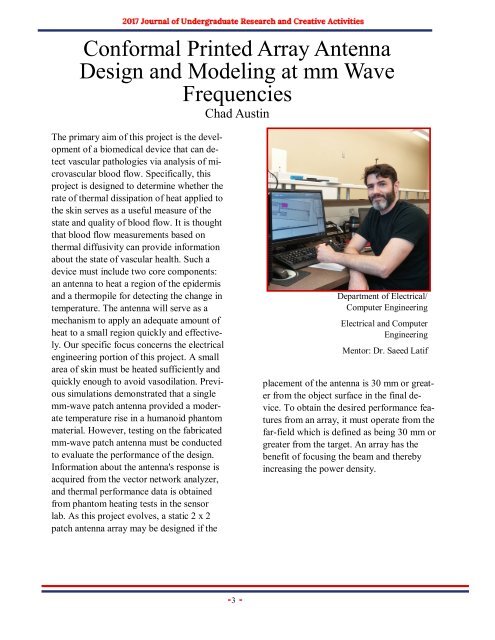JOURACA_SP_2017
Create successful ePaper yourself
Turn your PDF publications into a flip-book with our unique Google optimized e-Paper software.
Conformal Printed Array Antenna<br />
Design and Modeling at mm Wave<br />
Frequencies<br />
Chad Austin<br />
The primary aim of this project is the development<br />
of a biomedical device that can detect<br />
vascular pathologies via analysis of microvascular<br />
blood flow. Specifically, this<br />
project is designed to determine whether the<br />
rate of thermal dissipation of heat applied to<br />
the skin serves as a useful measure of the<br />
state and quality of blood flow. It is thought<br />
that blood flow measurements based on<br />
thermal diffusivity can provide information<br />
about the state of vascular health. Such a<br />
device must include two core components:<br />
an antenna to heat a region of the epidermis<br />
and a thermopile for detecting the change in<br />
temperature. The antenna will serve as a<br />
mechanism to apply an adequate amount of<br />
heat to a small region quickly and effectively.<br />
Our specific focus concerns the electrical<br />
engineering portion of this project. A small<br />
area of skin must be heated sufficiently and<br />
quickly enough to avoid vasodilation. Previous<br />
simulations demonstrated that a single<br />
mm-wave patch antenna provided a moderate<br />
temperature rise in a humanoid phantom<br />
material. However, testing on the fabricated<br />
mm-wave patch antenna must be conducted<br />
to evaluate the performance of the design.<br />
Information about the antenna's response is<br />
acquired from the vector network analyzer,<br />
and thermal performance data is obtained<br />
from phantom heating tests in the sensor<br />
lab. As this project evolves, a static 2 x 2<br />
patch antenna array may be designed if the<br />
Department of Electrical/<br />
Computer Engineering<br />
Electrical and Computer<br />
Engineering<br />
Mentor: Dr. Saeed Latif<br />
placement of the antenna is 30 mm or greater<br />
from the object surface in the final device.<br />
To obtain the desired performance features<br />
from an array, it must operate from the<br />
far-field which is defined as being 30 mm or<br />
greater from the target. An array has the<br />
benefit of focusing the beam and thereby<br />
increasing the power density.<br />
3

















